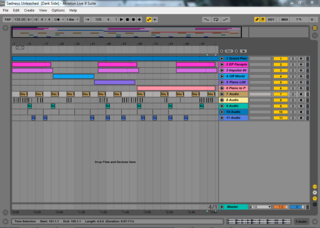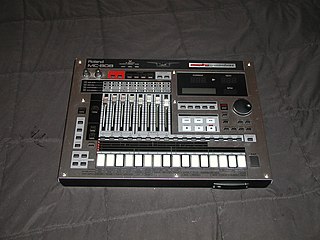
MIDI is a technical standard that describes a communication protocol, digital interface, and electrical connectors that connect a wide variety of electronic musical instruments, computers, and related audio devices for playing, editing, and recording music.

Digital music technology encompasses digital instruments, computers, electronic effects units, software, or digital audio equipment by a performer, composer, sound engineer, DJ, or record producer to produce, perform or record music. The term refers to electronic devices, instruments, computer hardware, and software used in performance, playback, recording, composition, mixing, analysis, and editing of music.
General MIDI is a standardized specification for electronic musical instruments that respond to MIDI messages. GM was developed by the American MIDI Manufacturers Association (MMA) and the Japan MIDI Standards Committee (JMSC) and first published in 1991. The official specification is available in English from the MMA, bound together with the MIDI 1.0 specification, and in Japanese from the Association of Musical Electronic Industry (AMEI).
A music workstation is an electronic musical instrument providing the facilities of:

A sampler is an electronic musical instrument that records and plays back samples. Samples may comprise elements such as rhythm, melody, speech, sound effects or longer portions of music.

Novation Digital Music Systems Ltd. is a British musical equipment manufacturer, founded in 1992 by Ian Jannaway and Mark Thompson as Novation Electronic Music Systems. Today the company specializes in MIDI controllers with and without keyboards, both analog and virtual analog performance synthesizers, grid-based performance controllers, and audio interfaces. At present, Novation products are primarily manufactured in China.

Ableton Live, also known as Live or sometimes colloquially as "Ableton", is a digital audio workstation for macOS and Windows developed by the German company Ableton.
Keytar is a keyboard instrument similar to a synthesizer or MIDI controller that is supported by a strap around the neck and shoulders, similar to the way a guitar is held.

A MIDI controller is any hardware or software that generates and transmits Musical Instrument Digital Interface (MIDI) data to MIDI-enabled devices, typically to trigger sounds and control parameters of an electronic music performance. They most often use a musical keyboard to send data about the pitch of notes to play, although a MIDI controller may trigger lighting and other effects. A wind controller has a sensor that converts breath pressure to volume information and lip pressure to control pitch. Controllers for percussion and stringed instruments exist, as well as specialized and experimental devices. Some MIDI controllers are used in association with specific digital audio workstation software. The original MIDI specification has been extended to include a greater range of control features.

Electronic drums are a modern electronic musical instrument, primarily designed to serve as an alternative to an acoustic drum kit. Electronic drums consist of an electronic sound module which produces the synthesized or sampled percussion sounds and a set of pads, usually constructed in a shape to resemble drums and cymbals, which are equipped with electronic sensors to send an electronic signal to the sound module which outputs a sound. Like acoustic drums, the pads are struck by drum sticks and they are played in a similar manner to an acoustic drum kit, albeit with some differences in the drumming experience.

A sound module is an electronic musical instrument without a human-playable interface such as a piano-style musical keyboard. Sound modules have to be operated using an externally connected device, which is often a MIDI controller, of which the most common type is the musical keyboard. Another common way of controlling a sound module is through a sequencer, which is computer hardware or software designed to record and playback control information for sound-generating hardware. Connections between sound modules, controllers, and sequencers are generally made with MIDI, which is a standardized interface designed for this purpose.

The Roland TR-505 rhythm composer is a drum machine and MIDI sequencer released by Roland Corporation in 1986. It hails from the same family of drum machines as the Roland TR-909, TR-808, TR-707, TR-626 and TR-606. The drum kit includes basic rock drum sounds similar to those of the TR-707, plus a complement of Latin-style drum sounds similar to those of the TR-727
Roland GS, or just GS, sometimes expanded as General Standard or General Sound, is a MIDI specification. It requires that all GS-compatible equipment must meet a certain set of features and it documents interpretations of some MIDI commands and bytes sequences, thus defining instrument tones, controllers for sound effects, etc.

The MC-808 is a groovebox introduced by Roland in 2006. It is the successor to the late Roland MC-303, Roland MC-307, Roland MC-505 and Roland MC-909.

The R-8 Human Rhythm Composer is an electronic drum machine introduced in 1989 by Roland Corporation, using PCM voices. The R-8 features velocity- and pressure-sensitive trigger pads, and the ability to create loops of beats. The device has eight individual outputs, 12-voice polyphony, and four-part multitimbral MIDI.
The Boss DR-220 Dr. Rhythm is a series of two budget-priced digital drum machines developed and manufactured by Boss Corporation beginning in 1985.

The Clavia Nord Drum is an analog modeling percussion synthesizer. It was first introduced at NAMM 2012, and was made available in March of 2012. Since then, two updated versions have been released; the Nord Drum 2 & Nord Drum 3P.

A digital accordion is an electronic musical instrument that uses the control features of a traditional accordion to trigger a digital sound module that produces synthesized or digitally sampled accordion sounds or, in most instruments, a range of non-accordion sounds, such as orchestral instruments, pipe organ, piano, guitar, and so on. Digital accordions typically encode and transmit key presses and other input as Musical Instrument Digital Interface (MIDI) messages. Most digital accordions need to be plugged into a keyboard amplifier or PA system to hear their sounds.
The Roland DDR-30 "Alpha Drum" is a digital PCM drum module built by Roland, in early 1985. It was introduced during 1985 Summer NAMM industry trade show in New Orleans.
The Korg DRM-1 Digital Rhythm module built by Korg, in late 1987. It was introduced during 1987 Summer NAMM industry trade show in Chicago.













